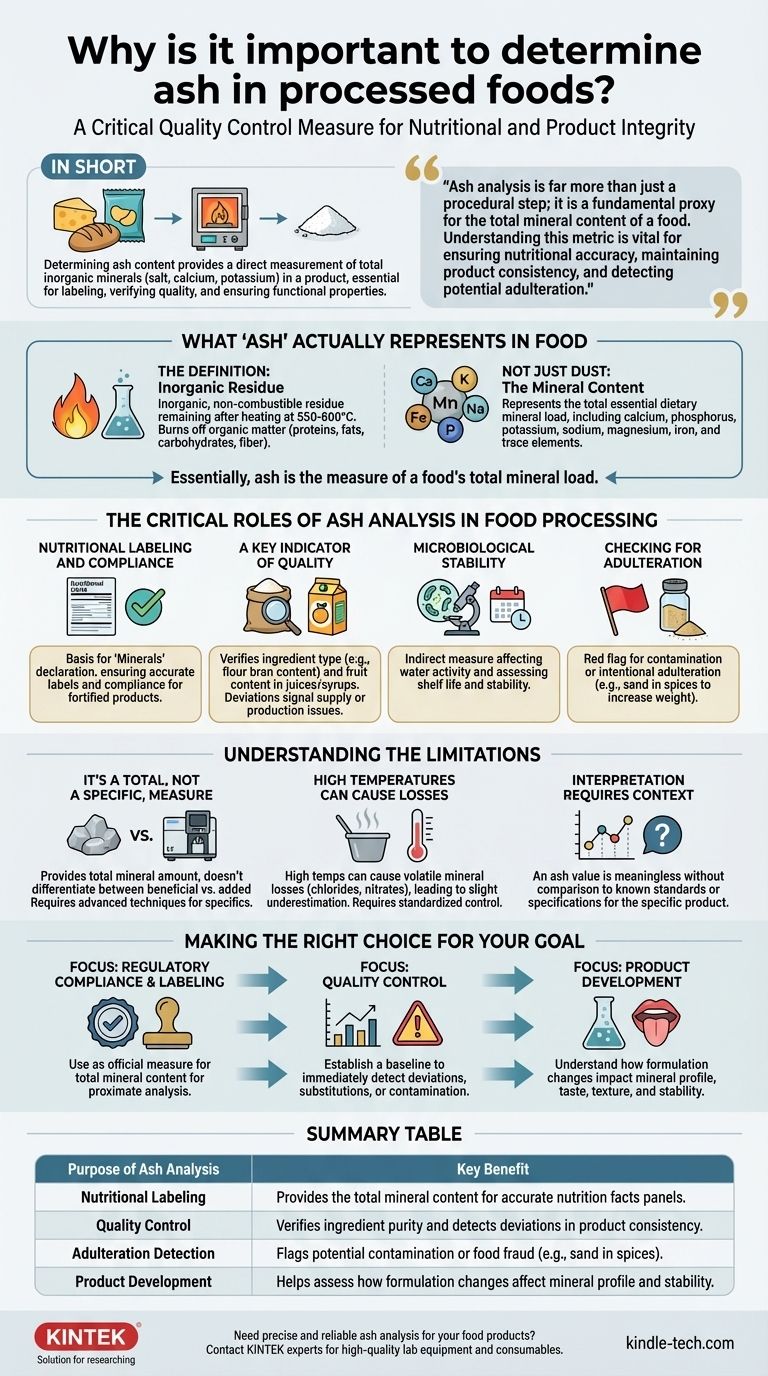Kurz gesagt, die Bestimmung des Aschegehalts von verarbeiteten Lebensmitteln ist eine kritische Maßnahme zur Qualitätskontrolle. Sie liefert eine direkte Messung der Gesamtmenge an anorganischen Mineralien – wie Salz, Kalzium und Kalium –, die in einem Lebensmittelprodukt vorhanden sind. Dieser einzelne Wert ist unerlässlich für die Nährwertkennzeichnung, die Überprüfung der Zutatenqualität und die Sicherstellung, dass das Endprodukt seine spezifischen funktionellen Eigenschaften erfüllt.
Die Ascheanalyse ist weit mehr als nur ein Verfahrensschritt; sie ist ein grundlegender Indikator für den gesamten Mineralstoffgehalt eines Lebensmittels. Das Verständnis dieser Metrik ist entscheidend, um die ernährungsphysiologische Genauigkeit zu gewährleisten, die Produktkonsistenz aufrechtzuerhalten und potenzielle Verfälschungen zu erkennen.

Was 'Asche' in Lebensmitteln tatsächlich darstellt
Die Definition: Anorganischer Rückstand
Der Begriff „Asche“ bezieht sich auf den anorganischen, nicht brennbaren Rückstand, der übrig bleibt, nachdem eine Lebensmittelprobe bei sehr hohen Temperaturen (typischerweise 550-600°C) erhitzt wurde.
Dieser Prozess, bekannt als Veraschung oder Einäscherung, verbrennt effektiv die gesamte organische Substanz – nämlich Proteine, Fette, Kohlenhydrate und Ballaststoffe.
Nicht nur Staub: Der Mineralstoffgehalt
Was zurückbleibt, ist der gesamte Mineralstoffgehalt des Lebensmittels. Dies sind die essenziellen Mineralien, die wir für die Gesundheit benötigen, wie Kalzium, Phosphor, Kalium, Natrium, Magnesium und Eisen, sowie Spurenelemente.
Im Wesentlichen ist Asche das Maß für die gesamte Mineralstoffbelastung eines Lebensmittels.
Die kritischen Rollen der Ascheanalyse in der Lebensmittelverarbeitung
Nährwertkennzeichnung und Konformität
Die Ascheanalyse ist ein Eckpfeiler der Proximalanalyse, des Systems zur Bestimmung des Makronährstoff- und Mineralstoffprofils eines Lebensmittels. Der Gesamtaschewert ist oft die Grundlage für die Deklaration „Mineralien“ auf einer Nährwerttabelle.
Regulierungsbehörden verlassen sich auf diese Daten, um sicherzustellen, dass Lebensmitteletiketten korrekt sind und dass angereicherte Produkte die deklarierte Menge an zugesetzten Mineralien enthalten.
Ein wichtiger Qualitätsindikator
Der Aschegehalt ist ein aussagekräftiger Indikator für die Qualität und Art der verwendeten Zutaten. In der Mehlherstellung beispielsweise deutet ein höherer Aschegehalt auf einen größeren Anteil an Kleie im Mehl hin, was dessen Backeigenschaften und die endgültige Textur beeinflusst.
Bei Fruchtsäften und Sirupen kann der Aschegehalt helfen, den Fruchtgehalt zu überprüfen und festzustellen, ob das Produkt verdünnt oder verfälscht wurde. Eine Abweichung vom erwarteten Aschewert signalisiert ein Problem in der Lieferkette oder Produktionslinie.
Mikrobiologische Stabilität
Die Menge und Art der Mineralien in einem Lebensmittel, bekannt als Wasseraktivität, kann dessen Anfälligkeit für mikrobielles Wachstum beeinflussen. Der Aschegehalt liefert ein indirektes Maß, das bei der Beurteilung der Haltbarkeit und Stabilität eines Produkts hilft.
Überprüfung auf Verfälschungen
Ein ungewöhnlich hoher Aschewert kann ein Warnsignal für Kontamination oder vorsätzliche Verfälschung sein. Zum Beispiel könnten Gewürze mit Sand oder gemahlenen Materialien verfälscht werden, um das Gewicht zu erhöhen, was den Aschegehalt drastisch und illegal erhöhen würde.
Dies macht die Ascheanalyse zu einem einfachen, aber effektiven ersten Screening-Tool für Lebensmittelbetrug und -sicherheit.
Die Grenzen verstehen
Es ist ein Gesamt-, kein spezifisches Maß
Die primäre Einschränkung der Ascheanalyse ist, dass sie einen Gesamt- oder Rohwert liefert. Sie sagt Ihnen die Gesamtmenge an Mineralien, unterscheidet aber nicht zwischen ihnen.
Sie kann Ihnen nicht sagen, wie viel der Asche nützliches Kalzium ist und wie viel Natrium aus zugesetztem Salz stammt. Dafür sind fortgeschrittenere Techniken wie die Atomabsorptionsspektroskopie (AAS) oder die induktiv gekoppelte Plasma-Massenspektrometrie (ICP-MS) erforderlich.
Hohe Temperaturen können Verluste verursachen
Die bei der Veraschung verwendeten hohen Temperaturen können zum Verlust bestimmter flüchtiger Mineralien wie Chloride und Nitrate führen. Dies kann zu einer leichten Unterschätzung des wahren Gesamtmineralstoffgehalts führen.
Die Methode muss sorgfältig kontrolliert und standardisiert werden, um sicherzustellen, dass die Ergebnisse wiederholbar und vergleichbar sind.
Die Interpretation erfordert Kontext
Ein Aschewert ist isoliert betrachtet bedeutungslos. Ein Wert von „2 % Asche“ ist nur nützlich, wenn er mit einem bekannten Standard oder einer Spezifikation für das betreffende Lebensmittelprodukt verglichen wird.
Es ist ein Vergleichsinstrument, das verwendet wird, um die Konsistenz über die Zeit zu verfolgen und sicherzustellen, dass ein Produkt innerhalb seines erwarteten Bereichs liegt.
Die richtige Wahl für Ihr Ziel treffen
Die Ascheanalyse ist eine grundlegende Technik mit unterschiedlichen Implikationen, je nach Ihrem Ziel.
- Wenn Ihr Hauptaugenmerk auf der Einhaltung gesetzlicher Vorschriften und der Kennzeichnung liegt: Verwenden Sie die Ascheanalyse als offizielle Messgröße für den gesamten Mineralstoffgehalt, der für die Proximalanalyse und Nährwertangaben erforderlich ist.
- Wenn Ihr Hauptaugenmerk auf der Qualitätskontrolle liegt: Legen Sie einen Basis-Aschegehalt für Ihre Rohstoffe und Fertigprodukte fest, um Abweichungen, Zutatensubstitutionen oder Kontaminationen sofort zu erkennen.
- Wenn Ihr Hauptaugenmerk auf der Produktentwicklung liegt: Verwenden Sie den Aschegehalt, um zu verstehen, wie neue Zutaten oder Rezepturänderungen das Mineralstoffprofil des Endprodukts beeinflussen, was sich direkt auf Geschmack, Textur und Stabilität auswirkt.
Letztendlich liefert dieser einfache Test einen aussagekräftigen und kostengünstigen Überblick über die Qualität, den Nährwert und die Authentizität eines Lebensmittels.
Zusammenfassungstabelle:
| Zweck der Ascheanalyse | Hauptnutzen |
|---|---|
| Nährwertkennzeichnung | Liefert den gesamten Mineralstoffgehalt für genaue Nährwerttabellen. |
| Qualitätskontrolle | Überprüft die Reinheit der Zutaten und erkennt Abweichungen in der Produktkonsistenz. |
| Nachweis von Verfälschungen | Weist auf mögliche Kontaminationen oder Lebensmittelbetrug hin (z. B. Sand in Gewürzen). |
| Produktentwicklung | Hilft zu beurteilen, wie Rezepturänderungen das Mineralstoffprofil und die Stabilität beeinflussen. |
Benötigen Sie präzise und zuverlässige Ascheanalysen für Ihre Lebensmittelprodukte? KINTEK ist spezialisiert auf hochwertige Laborgeräte und Verbrauchsmaterialien für genaue Lebensmitteltests. Unsere Lösungen helfen Ihnen, die Einhaltung der Nährwertvorschriften zu gewährleisten, die Produktqualität aufrechtzuerhalten und Ihre Marke zu schützen. Kontaktieren Sie noch heute unsere Experten, um das perfekte Analysegerät für die Anforderungen Ihres Labors zu finden.
Visuelle Anleitung

Ähnliche Produkte
- 1800℃ Muffelofen für Labor
- 1700℃ Muffelofen für Labor
- Hochtemperatur-Muffelofen für Laborentbinderung und Vorsintern
- 1400℃ Muffelofen für Labor
- Labor-Muffelofen-Bodenhub-Muffelofen
Andere fragen auch
- Was sind die Hauptkomponenten eines Hochtemperatur-Muffelofens? Ein Leitfaden zu den Kernsystemen
- Bei welcher Temperatur sollte ein Ofen betrieben werden? Von Wohnkomfort bis hin zu industriellen Prozessen
- Welche Konstruktionsmerkmale tragen zur Praktikabilität und Zuverlässigkeit eines Muffelofens bei? Schlüsselelemente des Designs für den Erfolg im Labor
- Was ist das Hauptmerkmal eines Muffelofens? Reine, kontaminationsfreie Erwärmung
- Wie funktioniert ein Hochtemperatur-Muffelofen? Erreicht kontaminationsfreie, gleichmäßige Erwärmung



















